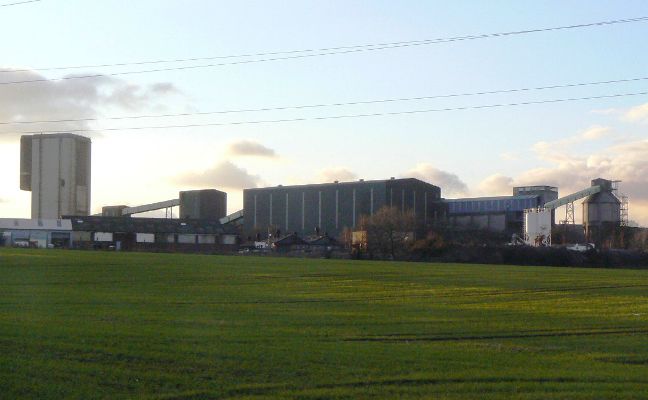 |
Northern Mine Research Society Registered Charity 326704 |
Maltby Colliery
 |
Copyright © Alan Murray-Rust and licensed for reuse under this Creative Commons Licence |
On the surface, the company installed one of the largest Capell fans then in use in the UK, capable of delivering 500,000 cfm against seven inches of water gauge, when running at 215 rpm. It had a 4.6 metre diameter impellor and double inlets of 3.2 metres in diameter, and was driven by a Robey cross compound engine. A pithead baths opened in 1927, with improved baths being built in 1939.
The mine was producing a million tons per annum from hand-filled longwall faces by the mid-1930s. Compressed air driven conveyor belts were installed in 1944. They carried coal from the face to loading points. In 1936 Maltby became part of the Amalgamated Denaby Collieries Ltd.
Upon nationalisation the National Coal Board began modernising the mine. By that time it was known that the shafts had been sunk onto the apex of an anticline and the seam sloped away on both sides. To remedy this, the shafts were deepened by 43 metres and new pit bottoms were built. New roadways were driven and a tower-mounted, multi rope friction winder was built over No.2 Shaft, where 12 ton capacity skips were installed. No.1 Shaft was fitted with an electrical winder. Diesel loco's were replaced by 95hp battery loco's pulling three ton mine cars.
By 1968, with reserves of the Barnsley seam being rapidly depleted, a three year project to develop the Swallow Wood began. As mining in this seam became established, work in the Barnsley came to an end in 1972 having exhausted all reserves. The Haigh Moor seam was worked from 1978 to 1979, but was abandoned owing to bad roof conditions. The Swallow Wood seam was worked until 1993 when it was considered to be worked out.
Prospection by boreholes proved significant reserves in the central and south-eastern parts of the colliery's take. In order to increase winding capacity, as part of developing reserves in the 1.5m thick Parkgate seam efficiently, work began on sinking the eight metre diameter No.3 Shaft, which was to be 991 metres deep. Sinking began in October 1982 and was completed in November 1989, and production from the first Parkgate face began in 1992. No.2 Shaft was deepened to 984 metres at this time.
British Coal temporarily stopped production at Maltby in May 1993 and put it on development only status in order to establish longwall retreat mining within the Parkgate Seam. At the time of privatisation production was due to re-start in September/October 1994. The reserves of the recently closed Silverwood Colliery were also transferred to Maltby.
After privatisation RJB Mining, which became UK Coal Mining Ltd in 2001, concentrated on working the Parkgate Seam to the north and north-east of the shafts. Some problems were anticipated with the effects on roof control of channel sandstones in the immediate roof of that seam. Although the Parkgate seam was on average less than 1.50 metre thick, the extracted height was about two metres which gave very low vends (40%). Nevertheless, the seam was ranked as a coking coal, which widened marketing options.
Because of its depth, Maltby was a hot mine, with ambient temperatures of up to 40°C. To help alleviate this, the unusual step of putting the main conveyor and other high powered equipment in the return airway was taken. This took their heat away from the face area.
The faces all had methane drainage schemes and each of the two working districts had its own booster fan. The airflow available for production faces averaged 45m³/second, but problems with high methane concentrations in the tailgates were experienced.
In 2007 Hargreaves Services plc bought Maltby, for £21.5 million, to provide coal for its New Monckton Coke Works. In May 2012, however, oil, water and gas seeped into the tailgate of a developing face (T125) which had to be abandoned. Faced with significant losses, the company issued redundancies notices and proposed mothballing the colliery. Instead, it was closed early in April 2013 and the surface plant cleared in 2014.
Further reading:
- NMRS Records, Gazetteer of British Collieries
- National Archives: BT31/34851/93304 (1907) Maltby Main Colliery Co. Ltd
- Coal News, October 1985 - Sinking No.3 Shaft.
- A Review of the Remaining Reserves at Deep Mines for the Department of Trade and Industry, IMC Group Consulting Limited, 2002.
- Sections of Strata of the Yorkshire Coalfield, Midland Institute of Mining Engineers, 1927
- Hill, A. The South Yorkshire Coalfield: A History and Development (Stroud: Tempus, 2002)
- Hill, A. Colliery Ventilation (Matlock: Peak District Mines Historical Society Ltd, 2000)
- Hill, A. Coal: A Chronology for Britain (NMRS, British Mining No.94, 2012)